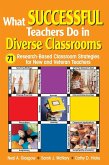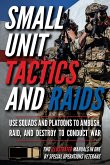- Gebundenes Buch
- Merkliste
- Auf die Merkliste
- Bewerten Bewerten
- Teilen
- Produkt teilen
- Produkterinnerung
- Produkterinnerung
With a practical, research-based model, this resource offers proven instructional methods that can be used across content areas and grade levels for students with or without disabilities.
Andere Kunden interessierten sich auch für
![63 Tactics for Teaching Diverse Learners, Grades 6-12 63 Tactics for Teaching Diverse Learners, Grades 6-12]() Bob Algozzine63 Tactics for Teaching Diverse Learners, Grades 6-1290,99 €
Bob Algozzine63 Tactics for Teaching Diverse Learners, Grades 6-1290,99 €![What Successful Teachers Do in Diverse Classrooms What Successful Teachers Do in Diverse Classrooms]() Neal A. GlasgowWhat Successful Teachers Do in Diverse Classrooms87,99 €
Neal A. GlasgowWhat Successful Teachers Do in Diverse Classrooms87,99 €![Teaching Science in Diverse Classrooms Teaching Science in Diverse Classrooms]() Douglas B. LarkinTeaching Science in Diverse Classrooms204,99 €
Douglas B. LarkinTeaching Science in Diverse Classrooms204,99 €![Killing America Killing America]() William DavidsonKilling America34,99 €
William DavidsonKilling America34,99 €![Teaching and Learning in Diverse Classrooms Teaching and Learning in Diverse Classrooms]() Carmelita Rosie CastañedaTeaching and Learning in Diverse Classrooms227,99 €
Carmelita Rosie CastañedaTeaching and Learning in Diverse Classrooms227,99 €![Small Unit Tactics and Raids Small Unit Tactics and Raids]() Matthew LukeSmall Unit Tactics and Raids115,99 €
Matthew LukeSmall Unit Tactics and Raids115,99 €![Teaching and Learning in a Diverse World: Multicultural Education for Young Children Teaching and Learning in a Diverse World: Multicultural Education for Young Children]() Patricia G. RamseyTeaching and Learning in a Diverse World: Multicultural Education for Young Children61,99 €
Patricia G. RamseyTeaching and Learning in a Diverse World: Multicultural Education for Young Children61,99 €-
-
-
With a practical, research-based model, this resource offers proven instructional methods that can be used across content areas and grade levels for students with or without disabilities.
Hinweis: Dieser Artikel kann nur an eine deutsche Lieferadresse ausgeliefert werden.
Hinweis: Dieser Artikel kann nur an eine deutsche Lieferadresse ausgeliefert werden.
Produktdetails
- Produktdetails
- Verlag: Corwin
- Seitenzahl: 160
- Erscheinungstermin: 23. Oktober 2008
- Englisch
- Abmessung: 286mm x 221mm x 13mm
- Gewicht: 680g
- ISBN-13: 9781412942379
- ISBN-10: 1412942373
- Artikelnr.: 24726719
- Herstellerkennzeichnung
- Produktsicherheitsverantwortliche/r
- Europaallee 1
- 36244 Bad Hersfeld
- gpsr@libri.de
- Verlag: Corwin
- Seitenzahl: 160
- Erscheinungstermin: 23. Oktober 2008
- Englisch
- Abmessung: 286mm x 221mm x 13mm
- Gewicht: 680g
- ISBN-13: 9781412942379
- ISBN-10: 1412942373
- Artikelnr.: 24726719
- Herstellerkennzeichnung
- Produktsicherheitsverantwortliche/r
- Europaallee 1
- 36244 Bad Hersfeld
- gpsr@libri.de
Bob Algozzine is a professor in the Department of Educational Leadership at the University of North Carolina and project codirector of the U.S. Department of Education-supported Behavior and Reading Improvement Center. With 25 years of research experience and extensive firsthand knowledge of teaching students classified as seriously emotionally disturbed, Algozzine is a uniquely qualified staff developer, conference speaker, and teacher of behavior management and effective teaching courses. He is active in special education practice as a partner and collaborator with professionals in the Charlotte-Mecklenburg schools in North Carolina and as an editor of several journals focused on special education. Algozzine has written more than 250 manuscripts on special education topics, including many books and textbooks on how to manage emotional and social behavior problems.
Preface
Acknowledgements
About the Authors
Part 1: Planning Instruction
1: Decide What to Teach
Assess to Identify Gaps in Performance
Establish Logical Sequences of Instruction
Consider Contextual Variable
2: Decide How to Teach
Set Instructional Goals
Establish Performance Standards
Choose Instructional Methods and Materials
Establish Groups Structures
Pace Instruction Appropriately
Monitor Performance and RePlan Instruction
3: Communicate Realistic Expectations
Teach Goals, Objective, and Standards
Teach Students to be Active, Involved Learners
Teach Students Consequences of Performance
Part II: Managing Instruction
4: Prepare for Instruction
Set Classroom Rules
Communicate and Teach Classroom Rules
Communicate Consequences of Behavior
Handle Disruptions Efficiently
Teach Students to Manage their own Behavior
5: Use Time Productively
Establish Routines and Procedures
Organize Physical Space
Allocate Sufficient Time to Academic Activities
6: Establish Positive Classroom Environment
Make the Classroom a Pleasant, Friendly Place
Accept Individual Differences
Establish Supportive, Cooperative Learning Environments
Create a Nonthreatening Learning Environment
Part III: Delivering Instruction
7: Present Information
Presenting Content
Motivating Students
Teaching Thinking Skills
Providing Relevant Practice
8: Monitor Presentations
Providing Feedback
Keeping Students Actively Involved
Ch. 9: Adjust Presentations
Adapt Lessons to Meet Student Needs
Provide Varied Instructional Options
Alter Pace
Part IV: Evaluating Instruction
10: Monitor Student Understanding
Check Understanding of Directions
Check Procedural Understanding
Monitor Student Success Rate
11: Monitor Engaged Time
Check Student Participation
Teach Students to Monitor their own Participation
Ch. 12: Keep Records of Student Progress
Teach Students to Chart their own Progress
Regularly Inform Students of Performance
Maintain Records of Student Performance
13: Use Data to Make Decisions
Use Data to Decide if More Services are Warranted
Use Student Progress to Make Teaching Decisions
Use Student Progress to Decide When to Discontinue Service
References
Additional Readings
Index
Acknowledgements
About the Authors
Part 1: Planning Instruction
1: Decide What to Teach
Assess to Identify Gaps in Performance
Establish Logical Sequences of Instruction
Consider Contextual Variable
2: Decide How to Teach
Set Instructional Goals
Establish Performance Standards
Choose Instructional Methods and Materials
Establish Groups Structures
Pace Instruction Appropriately
Monitor Performance and RePlan Instruction
3: Communicate Realistic Expectations
Teach Goals, Objective, and Standards
Teach Students to be Active, Involved Learners
Teach Students Consequences of Performance
Part II: Managing Instruction
4: Prepare for Instruction
Set Classroom Rules
Communicate and Teach Classroom Rules
Communicate Consequences of Behavior
Handle Disruptions Efficiently
Teach Students to Manage their own Behavior
5: Use Time Productively
Establish Routines and Procedures
Organize Physical Space
Allocate Sufficient Time to Academic Activities
6: Establish Positive Classroom Environment
Make the Classroom a Pleasant, Friendly Place
Accept Individual Differences
Establish Supportive, Cooperative Learning Environments
Create a Nonthreatening Learning Environment
Part III: Delivering Instruction
7: Present Information
Presenting Content
Motivating Students
Teaching Thinking Skills
Providing Relevant Practice
8: Monitor Presentations
Providing Feedback
Keeping Students Actively Involved
Ch. 9: Adjust Presentations
Adapt Lessons to Meet Student Needs
Provide Varied Instructional Options
Alter Pace
Part IV: Evaluating Instruction
10: Monitor Student Understanding
Check Understanding of Directions
Check Procedural Understanding
Monitor Student Success Rate
11: Monitor Engaged Time
Check Student Participation
Teach Students to Monitor their own Participation
Ch. 12: Keep Records of Student Progress
Teach Students to Chart their own Progress
Regularly Inform Students of Performance
Maintain Records of Student Performance
13: Use Data to Make Decisions
Use Data to Decide if More Services are Warranted
Use Student Progress to Make Teaching Decisions
Use Student Progress to Decide When to Discontinue Service
References
Additional Readings
Index
Preface
Acknowledgements
About the Authors
Part 1: Planning Instruction
1: Decide What to Teach
Assess to Identify Gaps in Performance
Establish Logical Sequences of Instruction
Consider Contextual Variable
2: Decide How to Teach
Set Instructional Goals
Establish Performance Standards
Choose Instructional Methods and Materials
Establish Groups Structures
Pace Instruction Appropriately
Monitor Performance and RePlan Instruction
3: Communicate Realistic Expectations
Teach Goals, Objective, and Standards
Teach Students to be Active, Involved Learners
Teach Students Consequences of Performance
Part II: Managing Instruction
4: Prepare for Instruction
Set Classroom Rules
Communicate and Teach Classroom Rules
Communicate Consequences of Behavior
Handle Disruptions Efficiently
Teach Students to Manage their own Behavior
5: Use Time Productively
Establish Routines and Procedures
Organize Physical Space
Allocate Sufficient Time to Academic Activities
6: Establish Positive Classroom Environment
Make the Classroom a Pleasant, Friendly Place
Accept Individual Differences
Establish Supportive, Cooperative Learning Environments
Create a Nonthreatening Learning Environment
Part III: Delivering Instruction
7: Present Information
Presenting Content
Motivating Students
Teaching Thinking Skills
Providing Relevant Practice
8: Monitor Presentations
Providing Feedback
Keeping Students Actively Involved
Ch. 9: Adjust Presentations
Adapt Lessons to Meet Student Needs
Provide Varied Instructional Options
Alter Pace
Part IV: Evaluating Instruction
10: Monitor Student Understanding
Check Understanding of Directions
Check Procedural Understanding
Monitor Student Success Rate
11: Monitor Engaged Time
Check Student Participation
Teach Students to Monitor their own Participation
Ch. 12: Keep Records of Student Progress
Teach Students to Chart their own Progress
Regularly Inform Students of Performance
Maintain Records of Student Performance
13: Use Data to Make Decisions
Use Data to Decide if More Services are Warranted
Use Student Progress to Make Teaching Decisions
Use Student Progress to Decide When to Discontinue Service
References
Additional Readings
Index
Acknowledgements
About the Authors
Part 1: Planning Instruction
1: Decide What to Teach
Assess to Identify Gaps in Performance
Establish Logical Sequences of Instruction
Consider Contextual Variable
2: Decide How to Teach
Set Instructional Goals
Establish Performance Standards
Choose Instructional Methods and Materials
Establish Groups Structures
Pace Instruction Appropriately
Monitor Performance and RePlan Instruction
3: Communicate Realistic Expectations
Teach Goals, Objective, and Standards
Teach Students to be Active, Involved Learners
Teach Students Consequences of Performance
Part II: Managing Instruction
4: Prepare for Instruction
Set Classroom Rules
Communicate and Teach Classroom Rules
Communicate Consequences of Behavior
Handle Disruptions Efficiently
Teach Students to Manage their own Behavior
5: Use Time Productively
Establish Routines and Procedures
Organize Physical Space
Allocate Sufficient Time to Academic Activities
6: Establish Positive Classroom Environment
Make the Classroom a Pleasant, Friendly Place
Accept Individual Differences
Establish Supportive, Cooperative Learning Environments
Create a Nonthreatening Learning Environment
Part III: Delivering Instruction
7: Present Information
Presenting Content
Motivating Students
Teaching Thinking Skills
Providing Relevant Practice
8: Monitor Presentations
Providing Feedback
Keeping Students Actively Involved
Ch. 9: Adjust Presentations
Adapt Lessons to Meet Student Needs
Provide Varied Instructional Options
Alter Pace
Part IV: Evaluating Instruction
10: Monitor Student Understanding
Check Understanding of Directions
Check Procedural Understanding
Monitor Student Success Rate
11: Monitor Engaged Time
Check Student Participation
Teach Students to Monitor their own Participation
Ch. 12: Keep Records of Student Progress
Teach Students to Chart their own Progress
Regularly Inform Students of Performance
Maintain Records of Student Performance
13: Use Data to Make Decisions
Use Data to Decide if More Services are Warranted
Use Student Progress to Make Teaching Decisions
Use Student Progress to Decide When to Discontinue Service
References
Additional Readings
Index








